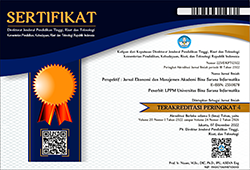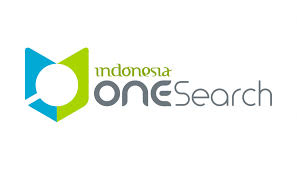Kreativitas Karyawan sebagai Variabel Mediasi antara Motivasi dan Kinerja Karyawan
Abstract
The optimal performance of employees is the hope of every company; in fact, employee performance still needs to be improved. This condition can be caused by employees' lack of motivation and creativity. Therefore, this study aimed to determine the extent to which employee creativity acts as an intermediary variable for employee motivation and performance variables. This study uses a quantitative method and a correlational design. The data collection technique is to use a purposive sample. The instrument used was a questionnaire that was distributed through Google Forms. This research was conducted on 73 employees at PT. Global Solutions Science. The data analysis technique used in this study is Structural Equation Modeling (SEM), and analyzed using SmartPLS. The results of this study indicate that work motivation has a moderate effect on performance, work motivation has a substantial effect on employee creativity, employee creativity has a moderate effect on performance, and motivation has a moderate effect through employee creativity on performance. This study concludes that strengthening employee creativity must be balanced with employee motivation to achieve optimal performance.
Keywords: Employee Creativity, Employee Performance, Motivation
Full Text:
PDFReferences
Agnoli, S., Runco, M. A., Kirsch, C., & Corazza, G. E. (2018). The role of motivation in the prediction of creative achievement inside and outside of school environment. Thinking Skills and Creativity, 28(May), 167–176. https://doi.org/10.1016/j.tsc.2018.05.005
Ambile, T. M., & Fisher, C. M. (2009). Stimulate Creativity by Fueling Passion. John Wiley & Sons.
Bernardin, H. J., & Russel, J. E. A. (2013). Human Resources Manajement. Mc GrawHill. Inc.
Bernardin, H.J., & R. (2010). Human Resources Management. MacGraw-Hill.
CARTER, E. M. A., & McMAHON, F. A. (2005). IMPROVING EMPLOYEE PERFORMANCE through workplace coaching. Kogan Page Limited.
Champoux, J. E. (2011). ORGANIZATIONAL BEHAVIOR:NTEGRATING INDIVIDUALS, GROUPS, AND ORGANIZATIONS. Routledge.
Chandrasekara, P., & Kappagoda, U. (2019). Impact of Creativity towards the Performance of Undergraduates of Rajarata University of Sri Lanka. International Journal of Scientific and Research Publications (IJSRP), 9(11), p95106. https://doi.org/10.29322/ijsrp.9.11.2019.p95106
Christensen, P. R. (1967). The One-Way Relation Between Creative Potential and IQ *. 7, 247–252.
Clarke, E. F. (2005). Creativity in performance. Musicae Scientiae, 9(1), 157–182. https://doi.org/10.1177/102986490500900106
Corpuz, J. T., Sullano Peña, G., & dela Torre Baconguis, R. (2022). Achievement, affiliation, power and academic performance of business management students of a state university in Cavite, Philippines. Cogent Social Sciences, 8(1). https://doi.org/10.1080/23311886.2022.2060538
CURWIN, J., SLATER, R., & EADSON, D. (2013). Ouantitative MethOds For Business Decisions. Cengage Learning.
Ferinia, R., & Hutagalung, S. (2017). Linkage Between McClelland Motivation Theory, Interpersonal Relationship, Employee Engagement and Performance of Nurses at Adventist Hospital. Advanced Science Letters, 23(11), 10955. https://doi.org/https://doi.org/10.1166/asl.2017.10196
Frost, S. (2018). How HR Can Contribute to Creating Competitiveness. Chron. https://smallbusiness.chron.com/hr-can-contribute-creating-competitiveness-38754.html
Fulmer, I. S., & Ployhart, R. E. (2014). “Our Most Important Asset”: A Multidisciplinary/Multilevel Review of Human Capital Valuation for Research and Practice. In Journal of Management (Vol. 40, Issue 1). https://doi.org/10.1177/0149206313511271
Garson, G. D. (2016). Partial Least Squares: Regression & Structural Equation Models. Statistical Associates Publishing.
Gibson, J. L., Ivancevich, J. M., Donnelly, J. H., & Konopaske, R. (2012). Organizations; Behavior, Structure, Processes (14th ed.). New York: McGraw-Hill.
Hidayat, S., Hadiyuswara, I. G., & Atomy, S. (2019). Achievement of Organizational Performance: the Role of Jobmotivation, Job Satisfaction, and Job Productivity. Jurnal Manajemen Bisnis, 10(2). https://doi.org/10.18196/mb.10176
Ina Kurniawati. H, & Elisabet Siahaan. (2021). Influence of Creativity, Self Efficacy, and Social Skills Toward Performance of Banking Employees. Journal Of Management Analytical and Solution (JoMAS), 1(2), 80–96. https://doi.org/10.32734/jomas.v1i2.6288
KBBI. (2016). Kamus Besar Bahasa Indonesia Online. https://kbbi.web.id/dinamit
Kondalkar, V. G. (2007). Organizational Behavior. New Delhi: New Age International.
Kurniawati, L. (2022). Literature review motivation and performance determination: Training analysis and performance assessment. Dinasti International Journal of Management Science, 3(6), 1047–1059. https://dinastipub.org/DIJMS/article/view/1305
Latham, G. P., & Pinder., C. C. (2005). Work Motivation Theory and Research at the Dawn of the Twenty-First Century. Annual Review of Psychology, 56, 485–516.
Maier, N. R. (1955). Psychology in Industry, 2nd ed. Houghton Mifflin.
McClelland, D. C. (1961). The Achieving Society. Van Nostrand Reinhold.
Mirvis, P. H., & Csikszentmihalyi, M. (1991). Flow: The Psychology of Optimal Experience. The Academy of Management Review, 16(3), 636. https://doi.org/10.2307/258925
Moskowitz, D. B. (2012). POOR JOB PERFORMANCE RATING MAY COST COMPANY DEARLY. Washington Post. https://www.washingtonpost.com/archive/business/1992/01/27/poor-job-performance-rating-may-cost-company-dearly/688a1eee-a1c4-4ee3-b69f-9371d7bbd913/
National Youth Council of Ireland. (2018). Why is Creativity Important and What Does it Contribute? National Youth Council of Ireland. https://www.youth.ie/articles/why-is-creativity-important-and-what-does-it-contribute/
Nohria, N., Groysberg, B., & Lee, L.-E. (2008). Employee Motivation: A Powerful New Model. HARVARD BUSINESS REVIEW PRESS.
Personio. (2020). How HR Can (And Should) Handle Underperforming Employees.
Robbins, S.P., & J. (2018). Essential Organizational Behavior (14th ed.). Pearson Education Limited.
Robbins, S.P., & Judge, T. A. (2018). Essential Organizational Behavior (14th ed.). New Jersey:Pearson Education, Inc.
Schermerhorn, J. R., Hunt, J. G., Osborn, R. N., & Uhi-Bien, M. (2010). Organizational Behavior (12th ed.). Pearson Education Inc.
Silalahi, U. (2015). Metode Penelitian Sosial Kuantitatif. Refika Aditama.
Soejarminto, Y., & Hidayat, R. (2022). Pengaruh Motivasi Kerja, Disiplin Kerja, Dan Lingkungan Kerja Terhadap Kinerja Karyawan Pt. Star Korea Industri MM2100 Cikarang. Ikraith-Ekonomika, 6(1), 22–32. https://doi.org/10.37817/ikraith-ekonomika.v6i1.2465
Sparrow, P. R., & Cooper, C. L. (2003). The Employment Relationship. Butterworth-Heinemann.
Stajkovic, A. D., & Luthans, F. (1998). Self- Efficacy and Work- Related Performance: A Meta-Analysis. Psychological Bulletin, 250–261.
Sudarmanto, E., Kurniullah, A. Z., Revida, E., Ferinia, R., Butarbutar, M., Abdilah, L. A., Sudarso, A., Purba, B., Purba, S., Yuniwati, I., Hidayatulloh, A. N., HM, I., & Suyuthi, N. F. (2021). Desain Penelitian Bisnis: Pendekatan Kuantitatif. Medan:Yayasan Kita Menulis.
Tanjung, R., Mawati, A. T., Ferinia, R., Nugraha, N. A., Parulian, H., Simarmata, M., Sudarmanto, E., Hasibuan, A., Gandasari, Dyah, I. K. D., Purba, B., Purba, S., & Silalahi, M. (2021). Organisasi dan Manajemen.
Tarmidi, D., Buana, U. M., Arsjah, R., Trisakti, U., & Performance, F. (2019). Employee and Organizational Performance: Impact of Employee Internal and External Factors, Moderated by Online Application. Journal of Resources Development and Management, January 2020. https://doi.org/10.7176/jrdm/57-04
Victor, J. (2022). 10,000 Google Employees Could Be Rated as Low Performers. The Information. https://www.theinformation.com/articles/10-000-google-employees-could-be-rated-as-low-performers
Vu, N. H., Nguyen, T. T., & Nguyen, H. T. H. (2021). Linking Intrinsic Motivation to Employee Creativity: The Role of Empowering Leadership. Journal of Asian Finance, Economics and Business, 8(3), 595–604. https://doi.org/10.13106/jafeb.2021.vol8.no3.0595
Woodbridge, C. (2020). The importance of motivation in the workplace. https://www.penguins.co.uk/incentive-travel-blog/the-importance-of-motivation-in-the-workplace
Yahyaa1, R. A., & Sukarnob, G. (2021). ANALISIS INOVASI DAN KREATIVITAS TERHADAP KINERJA KARYAWAN INDUSTRI SANDAL DAN SEPATU DI DESA WEDORO DI ERA PANDEMI COVID-19. Jurnal Ilmiah Ilmu Pendidikan Dan Sosial, 10(2), 178–193. https://ejournal.unibabwi.ac.id/index.php/sosioedukasi/article/view/1499
Zambas, J. (2022). Effects of Poor Management at Work: A List of Disadvantages. Career Addict. https://www.careeraddict.com/effects-poor-management
DOI: https://doi.org/10.31294/jp.v21i1.15520
Copyright (c) 2023 C.Venus Lurekke Jean Jr.

This work is licensed under a Creative Commons Attribution-ShareAlike 4.0 International License.
dipublikasikan oleh LPPM Universitas Bina Sarana Informatika Jakarta
Jl. Kramat Raya No.98, Kwitang, Kec. Senen, Kota Jakarta Pusat, DKI Jakarta 10450

This work is licensed under a Creative Commons Attribution-ShareAlike 4.0 International License










